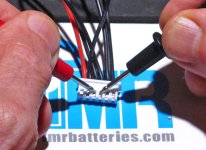Hi all, I haven't been on this site for years, my old username was "mechanix" but I don't know what email I used to register originally so I was unable to recover my password. I never really posted too much, but learned a lot from everyone. It's refreshing to see a lot of familiar faces as I'm looking around after all these years.
I started a build close to 5 years ago that I never really fully finished:
https://endless-sphere.com/forums/viewtopic.php?f=3&t=85838

It's been sitting in my garage ever since and I'm trying to figure out the best way to charge this beast to finish this project once and for all. I have two iCharger 1010B+ balancing chargers and some power supplies. The power supplies will have a common ground (using ATX power supplies with grounded plugs). There is continuity between the DC- and earth ground, so I thought to maybe just remove the ground plug on both the power supplies and not use this around water, etc. but I don't know if this would truly isolate the chargers. I have found two threads that talk about a similar problem:
https://endless-sphere.com/forums/viewtopic.php?t=20939
https://endless-sphere.com/forums/viewtopic.php?f=14&t=71464&start=25
Here is a picture of the wiring diagram I have currently, I am thinking about just removing the ground plug for the chargers, but am not sure if that will be enough to truly isolate the chargers so one isn't seeing 40V more that it is expecting:

I started a build close to 5 years ago that I never really fully finished:
https://endless-sphere.com/forums/viewtopic.php?f=3&t=85838

It's been sitting in my garage ever since and I'm trying to figure out the best way to charge this beast to finish this project once and for all. I have two iCharger 1010B+ balancing chargers and some power supplies. The power supplies will have a common ground (using ATX power supplies with grounded plugs). There is continuity between the DC- and earth ground, so I thought to maybe just remove the ground plug on both the power supplies and not use this around water, etc. but I don't know if this would truly isolate the chargers. I have found two threads that talk about a similar problem:
https://endless-sphere.com/forums/viewtopic.php?t=20939
https://endless-sphere.com/forums/viewtopic.php?f=14&t=71464&start=25
Here is a picture of the wiring diagram I have currently, I am thinking about just removing the ground plug for the chargers, but am not sure if that will be enough to truly isolate the chargers so one isn't seeing 40V more that it is expecting:



